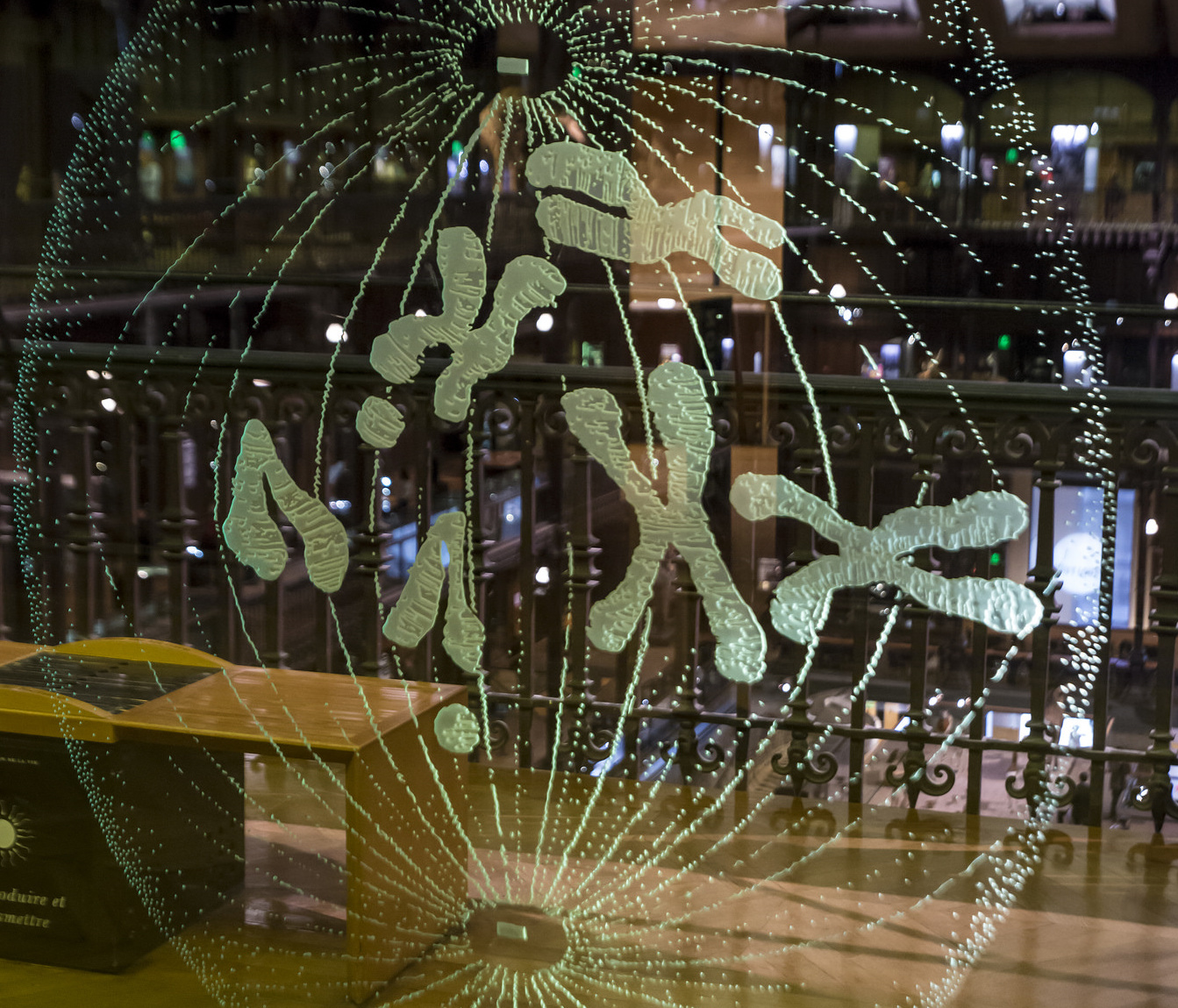The two chromosomes of cholera bacteria were shown to communicate with each other in fascinating ways to make sure their DNA replication happens in sync.

An installation depicting chromosomes at the Grande Galerie de l’Evolution, Paris, December 2015. Credit: Herman Pijpers/Flickr, CC BY 2.0
The life cycles of cells whose DNA is packed into a single chromosome, like 90% of bacterial species, is relatively simple. But in cells which have multiple chromosomes this gets more complicated. Here, the individual chromosomes within a cell have to ensure that each of them replicate once and only once before the cell splits into two. The signalling molecules and mechanisms responsible for this are still largely unknown.
Higher organisms, called eukaryotes, have a set of regulator molecules that make sure all the chromosomes replicate and segregate before the cell cleaves. However, these molecules are not chromosome-specific. On the other hand in bacteria like Vibrio cholerae, which has two circular chromosomes, each chromosome has different molecules that initiate and regulate replication.
Despite this degree of independence, the two differently-sized chromosomes – the primary chr1 is almost thrice as long as the secondary chr2 – time themselves such that they finish replicating at the same time, every single time! This observation strongly suggests that there is some inter-chromosomal communication in place here. Now, for the first time, scientists from France and Denmark have found evidence of such a mechanism.
Deconstructing cholera bacteria
The primary chromosome in V. cholerae, chr1, contains most of the important genes that take care of cellular function and toxicity. The smaller chr2 also has essential functions like metabolism and heat shock. Replication of chr1 initiates when a molecule called DnaA binds to a point on the chromosome called ori1. A little later, replication of chr2 commences at a point on it called ori2 – this time triggered by another molecule RctB. This delay in chr2 replication initiation seems engineered perfectly so that the two chromosomes complete replication simultaneously and the cell can begin cleavage to produce two daughter cells having a full set of genetic material each.
Ole Skovgaard from Roskilde University, Denmark, explained why this is important: “The bi-partite genome organisation in the Vibrio-related bacteria make them more competitive than they would be with their entire genome organised in a single chromosome; the timing of the cell cycle with synchronous termination add to this competitiveness, possibly in several ways… disturbances of the cell cycle will reduce the fitness in the wild.”
A perfect understanding
Skovgaard and a team of scientists from the Institut Pasteur, Paris, describe how chr2 monitors the replication status of chr1 to time its own replication in a paper published on April 22 in the journal Science Advances. Crucial to this, they found, is a region on chr1 they named crtS that the chr2 initiator molecule RctB binds with to enhance chr2 replication. Chr1 replicates along its circular path and the moment the crtS region is covered, RctB molecule is activated and replication of chr2 is triggered soon after. It also appeared that there was physical proximity between crtS on chr1 and ori2 on chr2 during the cell cycle. In this way crtS acts as a timer region and seems to be a way via which chr1 could communicate to chr2 that the time to start is now.
To confirm its role, the scientists created bacteria with a deleted crtS region. They found that this resulted in severely impaired growth and filamentation and DNA damage. Interestingly, they noticed that a few cells escaped this fate. “They did this through a fusion between chr1 and chr2. Now replication of chr2 will piggyback on chr1 and the cell will recover,” explained Skovgaard.
In addition, the scientists also conducted a 200-generation evolution experiment where crtS-deleted mutants were cultivated and observed for 200 generations. The idea was to find out what kind of mutations were developing in the mutant cells that would allow them to compensate from the crtS loss. “We found that the evolution experiments led solely to mutations in the gene for RctB,” said Skovgaard. “This further strengthens our idea that activation of RctB by replication of crtS is crucial for initiation at ori2. The RctB mutants are likely… independent of crtS replication-activation.”
A novel mechanism
A 2014 study by Baek and Chattoraj first described the possible role of such a site (they had not named it crtS yet) on V. cholerae’s chr1, though they reported that the role of the site was much more modest. The team involved in the current study chalk down the differences in the two observations to the compensatory mutations that develop, making it appear that crtS loss is not crucial to the cell.
This is the first time that such a checkpoint mechanism – where active replication of a short DNA sequence is sensed and the signal is sent to a different process – has been identified in bacteria, but Skovgaard believes that it’s only a matter of time before more cases are spotted. “This novel mechanism is an elegant and cost-effective way for secondary chromosomes to benefit from the already well-adapted replication regulatory system of the host main chromosome,” write the authors.
In an era where research teams around the world are trying to build a cell from scratch, knowledge about such finer aspects of cellular control could be a boon. “We envisage many different ways to use such a mechanism,” they conclude.